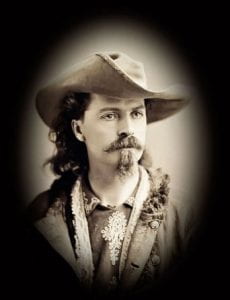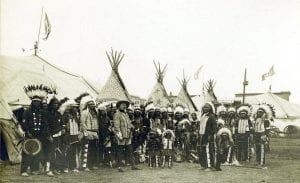
As discussed in last week’s post, Janee Becker’s thesis is investigating The Wigwam, the former home of Major Israel McCreight and campsite for the Native American performers in the famous Buffalo Bill’s Wild West Show. Along with his partner Dr. W.F. Carver, William F. “Buffalo Bill” Cody, opened his Wild West show on May 19, 1883 in Omaha Nebraska. His show included cowboys (and girls), Indians, military formations, mock battles and hunt, trick shooting and riding, and creative storylines connecting all performances. Buffalo Bill’s and many other rival Wild West shows often depicted major events occurring in the mysterious wild west, all while promoting the idea of westward expansion. Americans were not the only people fascinated by the West. Buffalo Bill’s Wild West Show opened in London on May 9, 1887 and traveled throughout Europe.
Native Americans played an extremely important role in the show.  For the most part, they were treated and paid well, able to travel with their families, and able to retain their traditional ways of life. Despite these positive aspects of the show, they were still viewed as warlike savages preventing the expansion of civilization into the West. The Native American victory at Little Big Horn was even used to show audiences why westward expansion is needed. In the 1890s Buffalo Bill’s employed hundreds of Native Americans, vastly outnumbering the number of cowboys and cowgirls.
For the most part, they were treated and paid well, able to travel with their families, and able to retain their traditional ways of life. Despite these positive aspects of the show, they were still viewed as warlike savages preventing the expansion of civilization into the West. The Native American victory at Little Big Horn was even used to show audiences why westward expansion is needed. In the 1890s Buffalo Bill’s employed hundreds of Native Americans, vastly outnumbering the number of cowboys and cowgirls.
Women were also included in the Wild West Shows. Some had spotlighting roles as sharpshooters like Annie Oakley and Princess Wenona, the Indian Girl Shot (Lillian Smith) while others portrayed rancheras and Indian captives. Lucille Muhall even made a name for herself as a roper and Rough Rider. According to records from Buffalo Bill’s women performers were paid the same as men. African Americans also participated in Wild West shows, although in minor roles. They often portrayed cowboys, were members of the all-black 9th and 10th US Cavalry units, or as part of the band.

These live shows declined in the early 1900s with the introduction of television and movies and the increasing popularity of sports. World War I also created problems for the shows. The Miller Brothers 101 Ranch Real Wild West show had all of their horses taken for the war effort performing in Great Britain in August 1914. The Buffalo Bill’s Wild West Show went bankrupt in July 1913 and in 1917 both the industry and Buffalo Bill Cody had passed.
Source: https://centerofthewest.org/learn/western-essays/wild-west-shows/
Follow IUP Anthropology on Facebook, Twitter, and Instagram